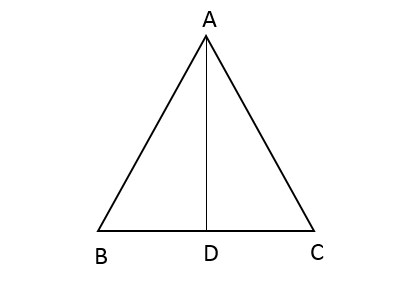Answer
424.5k+ views
Hint: For solving these types of question, students must know about the figure. Use the Pythagoras theorem to find the base of all right angled triangle i.e. ${\left( {Hypotenuse} \right)^2} = {\left( {Base} \right)^2} + {\left( {Height} \right)^2}$. In isosceles triangle two sides and two angles are same and equal
Complete step by step answer:

Given, $\vartriangle ABC$is an isosceles triangle
$AD$ is an altitude of triangle
$AD = 4cm$$,BC = 8cm$
$BD = DC = 4cm$
In $\vartriangle ABD$
Let $AB$$ = xcm$
By using Pythagoras theorem
$A{B^2} = A{D^2} + B{D^2}$
Put the values of $AB,AD$and $BD$
$ \Rightarrow {x^2} = {4^2} + {4^2}$
${x^2} = 16 + 16$
Now we get ${x^2} = 32$
Now take square root on both sides
$ \Rightarrow $ $\sqrt {{x^2}} = \sqrt {32} $
$x = \sqrt {32} $
So we get $x = 5.7$
$ \Rightarrow AB = 5.7cm$
We know that $\vartriangle ABC$is an Isosceles triangle.
$ \Rightarrow AB = AC = 5.7cm$
Which is the required answer.
So, the correct answer is “Option C”.
Note:
In this type of question, we should have to draw the figure first which is asked in the question. For solving these types of questions students should know all properties of the figure. Also, one should apply the Pythagoras theorem properly and don’t do any mistakes in calculation. Application on the Pythagorean Theorem is used to check whether the triangle is acute, obtuse, or right.
If \[{a^2}{\text{ }} + {\text{ }}{b^2}{\text{ }} = {\text{ }}{c^2}\], then the triangle is right.
If \[{a^2}{\text{ }} + {\text{ }}{b^2}{\text{ > }}{c^2}\], then the triangle is acute.
If \[{a^2}{\text{ }} + {\text{ }}{b^2}{\text{ < }}{c^2}\], then the triangle is obtuse.
Where $c$ represents the length of the hypotenuse, $a$ and $b$ represent the lengths of the other two sides.
Complete step by step answer:

Given, $\vartriangle ABC$is an isosceles triangle
$AD$ is an altitude of triangle
$AD = 4cm$$,BC = 8cm$
$BD = DC = 4cm$
In $\vartriangle ABD$
Let $AB$$ = xcm$
By using Pythagoras theorem
$A{B^2} = A{D^2} + B{D^2}$
Put the values of $AB,AD$and $BD$
$ \Rightarrow {x^2} = {4^2} + {4^2}$
${x^2} = 16 + 16$
Now we get ${x^2} = 32$
Now take square root on both sides
$ \Rightarrow $ $\sqrt {{x^2}} = \sqrt {32} $
$x = \sqrt {32} $
So we get $x = 5.7$
$ \Rightarrow AB = 5.7cm$
We know that $\vartriangle ABC$is an Isosceles triangle.
$ \Rightarrow AB = AC = 5.7cm$
Which is the required answer.
So, the correct answer is “Option C”.
Note:
In this type of question, we should have to draw the figure first which is asked in the question. For solving these types of questions students should know all properties of the figure. Also, one should apply the Pythagoras theorem properly and don’t do any mistakes in calculation. Application on the Pythagorean Theorem is used to check whether the triangle is acute, obtuse, or right.
If \[{a^2}{\text{ }} + {\text{ }}{b^2}{\text{ }} = {\text{ }}{c^2}\], then the triangle is right.
If \[{a^2}{\text{ }} + {\text{ }}{b^2}{\text{ > }}{c^2}\], then the triangle is acute.
If \[{a^2}{\text{ }} + {\text{ }}{b^2}{\text{ < }}{c^2}\], then the triangle is obtuse.
Where $c$ represents the length of the hypotenuse, $a$ and $b$ represent the lengths of the other two sides.
Recently Updated Pages
How many sigma and pi bonds are present in HCequiv class 11 chemistry CBSE

Why Are Noble Gases NonReactive class 11 chemistry CBSE

Let X and Y be the sets of all positive divisors of class 11 maths CBSE

Let x and y be 2 real numbers which satisfy the equations class 11 maths CBSE

Let x 4log 2sqrt 9k 1 + 7 and y dfrac132log 2sqrt5 class 11 maths CBSE

Let x22ax+b20 and x22bx+a20 be two equations Then the class 11 maths CBSE

Trending doubts
Fill the blanks with the suitable prepositions 1 The class 9 english CBSE

At which age domestication of animals started A Neolithic class 11 social science CBSE

Which are the Top 10 Largest Countries of the World?

Give 10 examples for herbs , shrubs , climbers , creepers

Difference between Prokaryotic cell and Eukaryotic class 11 biology CBSE

Difference Between Plant Cell and Animal Cell

Write a letter to the principal requesting him to grant class 10 english CBSE

Change the following sentences into negative and interrogative class 10 english CBSE

Fill in the blanks A 1 lakh ten thousand B 1 million class 9 maths CBSE



